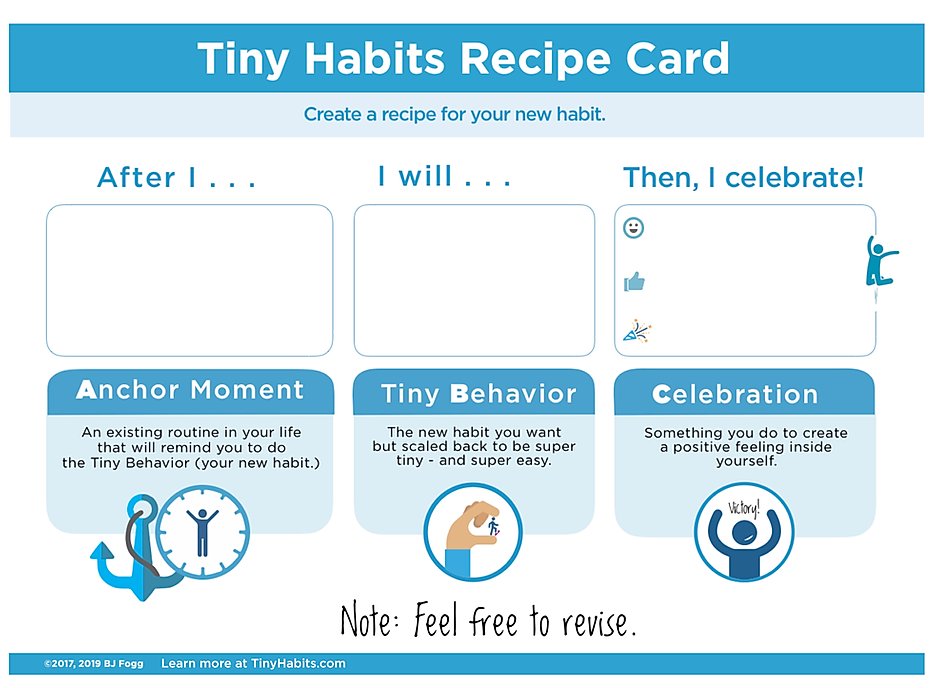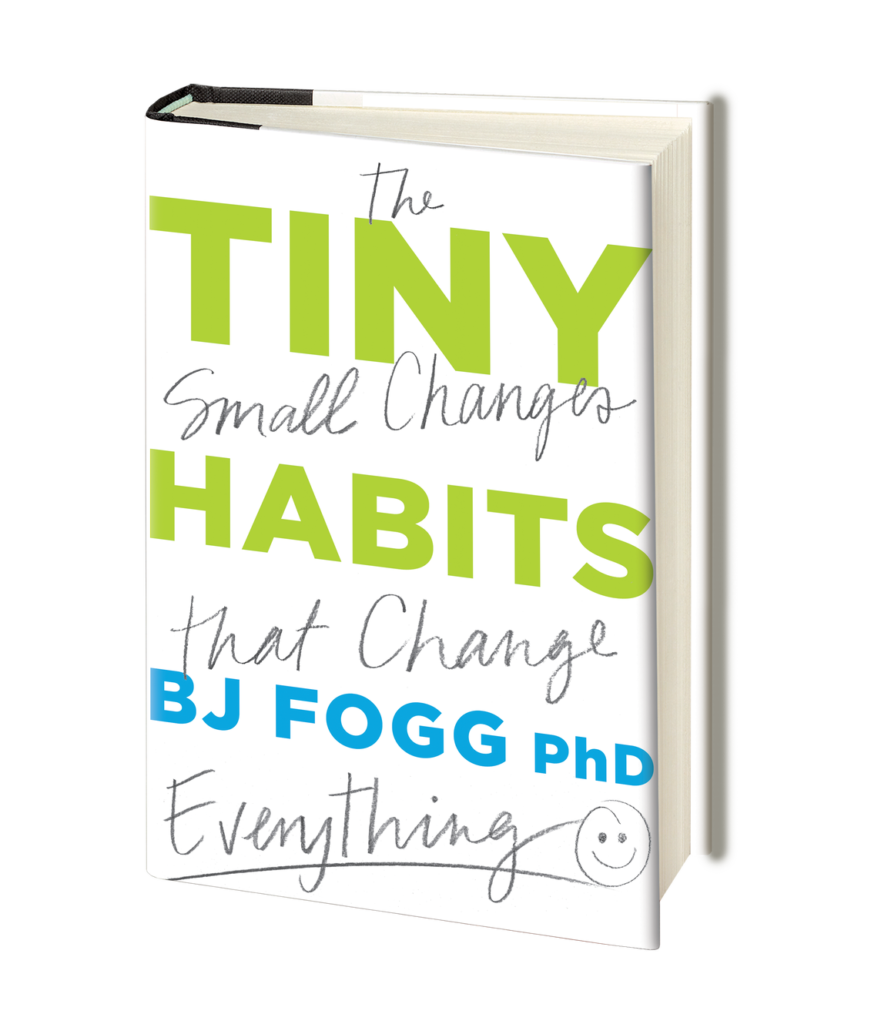What is the least you can do to be the best you can be?
Tiny Habits answers this question and several others on behaviour change and self-improvement.
Tiny Habits by B.J Fogg Phd. $16.79USD (Amazon) ISBN:9780358003328
Dr. BJ Fogg is a lecturer and research scientist at Standford University. He could be labeled as the ‘grandfather’ of Instagram since one of his students took his ideas on behavioural change to create the app. It’s no wonder that people such as Tim Ferriss, Ramit Sethi and _James Clear cite the work of Dr. Fogg.
Author’s main argument
The main idea of Tiny Habits is that for Behaviour Change to be successful, it should be easy and fun.
Dr Fogg stresses the importance of making the new habit as easy as possible to incorporate into your already existing routines. He also explains why bad habits such as endless scrolling on social media ( Youtube, Facebook) are so hard to break. Most of our ‘bad’ habits deliver some reward that is out of proportion to the effort needed to do them.
As the author states, “ The essence of Tiny Habits is this: take a behaviour you want, make it tiny, find where it fits naturally in your life, and nurture its growth.”
This is where most Habit Change methods fall down. There are two prevailing ideas that lead to failure:
- Go Big or Go Home
- It takes 21 days to make a new habit
Both of these ideas are false and in some ways dangerous to your long-term success and mental health. In a previous post I explained how feeling successful even in a small way helps a habit to grow. It cannot be stressed enough that when trying some aspect of self-improvement (losing weight, reading/praying/meditating every day), you might NEVER succeed at ALL of the components. When you plant the seed of a habit and nurture it, one day it will bear the fruit of success.
Three main points
Dr. Fogg puts forward three maxims that are instrumental in Behaviour Change.
- Simplicity changes behaviour
- Help people do what they already want to do
- Help people feel successful
Let’s look at each of these in-depth.
Simplicity changes behaviour –
This is the very antithesis of the ‘Go Big or Go Home’ mentality so prevalent in most self-development books. The easier something is to do, the more likely you are to do it. Imagine trying to change a habit by carrying a weight in your hand while walking one mile. Would you be more able to complete the walk if you had carried one bean or if you carried a rock the size of a watermelon? Would you be more likely to take the walk regularly if you carried one bean or the rock?
What Tiny Habit teaches is that to build a walking ritual you shouldn’t even begin by walking. You begin by putting your walking shoes on, even if you don’t take a step outside. And, before you do even that, make it clear in your schedule where and when this walking is to take place. Only then will it be safe to start your new routine.
Help people do what they already want to do
What do you really and truly WANT to do? What are the results we really wish to have? One of the big mistakes of Behavioural Change is the belief that there is ONE way to achieve the goal. It is your duty to master that one prescribed technique.
Tiny Habits shows that this is false. The reader is asked to be honest about what they will and won’t do to reach their desired outcome. Look at this graph split into four quadrants.
For example, we’ll use weight loss as the Aspiration, and dropping 25 pounds in one year is the expected Outcome.
Note: Aspiration – Abstract idea
Outcome – the measurable result
Behaviour – some action you will take at a given moment in time
The first step is to write out all possible behaviours. Dr. Fogg says that no idea, however ridiculous should be dismissed at this point. This list of possible behaviours might include: Eat a piece of fruit every moning, walk five miles a day with a rock the size of a watermelon, park further away from work, join a gym, stop eating after 8:00 pm, go for a mid-day stroll, stop buying soda and ice-cream for your household, do three squats after every trip to the toilet, drink more water and so forth.
After you write these out, decide where they should go on the chart. Can you get yourself to walk five miles toting a rock (probably not)? That would go in the upper left of the chart, refuse to buy soda and ice-cream? That would go in the top right. Each behaviour is evaluated based on whether you’d actually do them AND the impact they will have on your expected outcome.
At the end of the exercise, you will have a group of behaviours that you use to reach your aspiration. Not every behaviour will have to become a habit, you’ll realize that there are one-time events that have an impact. There are two major benefits to this method. First, it is tailored to your, needs, abilities, and motivations. Secondly, if any single behaviour doesn’t work as expected or is too hard, you can drop it and focus on the ones that are working.
Help people feel successful
The Tiny Habits Method is designed to work at more than just a personal level. The method has proven to work in business and various types of organizations. This is because, as previously mentioned, people are more likely to repeat a behaviour when they feel successful and they are doing what they want to do.
“Nothing succeeds like success” – Alexandre Dumas
Understanding the technique
The application of the Tiny Habits method is based on simplicity and brain chemistry. (Really!!)

We’ll break it down. All habits need a prompt, something to trigger the start of the behaviour. No prompt, no action. In Tiny Habits the prompt is something you already do on a daily basis. The hardest part is deciding where the new habit should fit. Clearly, a flossing routine should be added around the time you brush your teeth. A reading habit might fit in around the time you eat lunch or just when you get into bed at night. It is up to you to decide.
In the beginning make the new habit as easy as possible. Choose the floss that is right for you and if necessary, do only one tooth each night. If you begin the reading at lunch habit, take out the book/tablet as soon as you feel hunger pangs. When you begin to eat, the reading material is right in front of you.
Should you decide to make walking after work is your way to better health, don’t begin with some unnatural goal like five miles each day. Start the habit simply, when the clock reaches 5:00 pm put on your walking shoes. Even if you sit at your desk for another two hours or only walk to your car ( feeling silly) you’ve been successful.
Now for the Secret Sauce of Tiny Habits. Celebrate!!
Each time you actually do your tiny habit, celebrate it. Give yourself a quick thumbs up, sing a verse of your favourite song, smile and say “you are doing a good job!” A ‘Celebration’ is anything that gives you a good feeling. Celebrate immediately after the behaviour if you want it to become a habit.
Each time we celebrate we are re-wiring our brain to enjoy/accept the new behaviour. Failing to celebrate the new habit means it will take longer to be embedded or not do so at all.
Critique
Originality and intended audience
If you are a fan of Self-Improvement literature or just want to permanently lock-in behaviours that make your life better, then this is a must-read. Dr. Fogg’s work in the field of Behaviour Design is well documented. He is a pioneer in various areas of human psychology, particularly persuasive technology. The idea of using a ‘celebration’ to improve the odds of success in habit change is definitely new and sure to become a cornerstone of future works about designing habits.
Ease of reading
Anyone with a 9th-grade reading level can easily make it through the entire book and anyone with a 5th-grade level of reading comprehension will understand and utilize the concept at the core of the book.
Find an anchor moment. Do the tiny habit. Celebrate.
Despite the ease of reading, anyone doing an advanced degree in Psychology or related field can also use the book. It is loaded with references to published studies and Dr. Fogg’s own work at Stanford.
One criticism of Tiny Habits is that stories about some of his ‘habiteers’ (people who practice tiny habits) can drag on for pages without advancing the understanding of the technique.
My main criticism is that while Dr. Fogg encourages the reader to immediately begin working on their own tiny habits within the first three chapters, some of the necessary supplementary tactics are buried further in the book. This does not mean you will fail at what you are trying to do, but it could be easier for you if it were arranged better.
How does this book fit in with the other books I’ve reviewed
This is my third review of a book about habit change. The previous books; Atomic Habits and Small Move, Big Change both touted different methods for Self-Improvement through focusing on building habits.
Atomic Habits by James Clear had four principles that if managed properly could get the desired results but there was no emphasis on ‘feeling’ or the need to celebrate. I still use my Habits Journal to ensure that I do the behaviours necessary for my success but it is not as motivating.
Small Move, Big Change by Caroline Arnold has one principle. To reach your desired outcome, you need to work on it relentlessly until you achieve success. There is no regard for how you feel about it, but as you are only focused on one habit at a time, the technique will work.
Conclusion
The use of celebration will be a game-changer in the field of behaviour modification. Tiny Habits has added a small modifier to the process of how we can improve the process of learning better habits.
As for me, my morning routine has led to me keeping my bedroom floor swept and clothes put away which has become a nice bonus to a tiny habit which makes me highly recommend this book to you.
Resources
Tiny Habits website
Tiny Habits free videos
To order tiny habits book go HERE.
Ordering the book earns me a small commission.


Speak Your Mind